Scotching the Wind
Air Date: Week of September 26, 2008
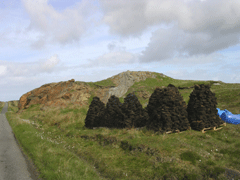
Peatstacks line the roadsides ready for collection. (Photo: Tom Allan)
Even in Europe, there are some places barely touched by time. For example, on the Scottish Isle of Lewis, people speak Gaelic and still stoke home-fires with peat dug from family bogs. But a recent plan to bring a giant windfarm to the island drew fierce opposition from environmentalists and residents who want to preserve the peatlands and their traditional ways of life. Tom Allan reports.
Transcript
GELLERMAN: Far in the northwest of Scotland, where the wind sweeps in from the sea, you’ll find the Isle of Lewis. Here, life is different. Traditions are long lived and run deep, woven like the tweed the island is known for. On Lewis, Sabbath psalms are sung in Gaelic. The place looks barren and tree-less but rare birds thrive on the wetlands, and a thin layer of grass and moss hide Lewis’ most valuable resource – peat. Dark and rich, the peat is the product of thousands of years of dead plants, layer upon layer, preserved in the marshy waters, dug up and burned as fuel. But proponents of a new source of energy – wind – hoped to build on the peat bogs and as Tom Allan found, they ran hard into the Isle of Lewis’ historic roots.
[CRACKLING OF COAL IN A FORGE AND THE SOUND OF ELECTRIC BELLOWS]
ALLAN: Seventy-four-year-old blacksmith Callum Macleod stands poised in the dark of his forge, waiting for the metal in the fire to glow white. His face is lit up by the embers, as the whirring electric bellows pours sparks into the air. Suddenly, he pulls the steel out of the fire, and onto the anvil.
[SOUND OF HAMMERING METAL]
ALLAN: He's making a Tarasgeir, the gaelic name for a peat iron – the heavy bladed pole used to cut peat.
MACLEOD: The hammering is hardening the metal, it's making the blade rigid.
[HAMMERING PAUSES]
MACLEOD: I reckon my father made at least six thousand in his time. And I know since I started I've made up to three thousand, all together.
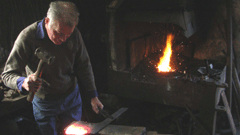
Callum Macleod forges a tarasgeir. (Photo: Tom Allan)
ALLAN: But orders for Callum's peat irons had dwindled in recent years - until this year, when they shot up.
MACLEOD: And they're still wanting ‘em.
ALLAN: And why do you think they've gone back up?
MACLEOD: Oh, well, the cost of fuel. The price of oil. The price of oil. If anybody has an open fire or a stove, it saves them a lot. The price of coal, even, and that it saves a lot of money just cutting a few peats to throw on the fire in the wintertime.
[RUSTY GATE OPENING AND FOOTSTEPS BEGINNING]
ALLAN: Ian Macintosh leads me up to the family peat banks on the edge of the moor above the town of Stornoway, the island’s diminutive capital. From up here the landscape is flat and unbroken, except for the exposed peatbanks, and the gentle roll of the Barvas hills in the distance.
[SOUND OF FOOTSTEPS AND BIRDSONG]
MACINTOSH: [LAUGHING] I'll probably be out of puff by the top of the hills.

Ian Macintosh loads his tractor with dried peats. (Photo: Tom Allan)
[FOOTSTEPS AND BIRDSONG CONTINUES]
ALLAN: It may look barren, but peatlands are incredibly important. They absorb and store vast quantities of carbon dioxide, helping to keep the planet's atmosphere in balance. Peatlands cover 3% of the earth's surface and are also an excellent home for birds and wildlife.
MACINTOSH: ...not sure what bird that is in the distance, I think we'd heard it earlier on.
ALLAN: Ian Macintosh, and his father before him, have cut the peat on this spot for fifty years. It's a bit like having your own coal mine – only the water soaked peat needs to be dried out before it can be burnt.
MACINTOSH: That's it.
ALLAN: Ian's already made some rows of neatly stacked peats, like small brown teepees.

Peatstacks line the roadsides ready for collection. (Photo: Tom Allan)
MACINTOSH: Here's me trying to remember where I've left the peat iron.
ALLAN: In return for a little help bagging the dry peats, he's going to show me how the cutting is done.
[MACINTOSH GIVING INSTRUCTIONS, LOTS OF ACTION]
MACINTOSH: You'll have one chap standing up here, and …
[SOUND OF STAMPING IN THE PEAT IRON]
MACINTOSH: … you kick the peat forward. It's a two man job, so the other person is down here. You'll have someone else waiting here to pick up the peat, and basically lay it like that. Stack them up, like so.
ALLAN: He lets me cut the second layer of peat. I stand on the bank, and push the broad blade down hard with my foot. The force isn't needed – the peat's soft and rich, almost like brown butter in texture. There's quite an art to the whole process. The depth of the cuts, the size and thickness of the pieces, and the exact way in which Ian stacks them, all contribute to getting a fine, dry peat for the fire.
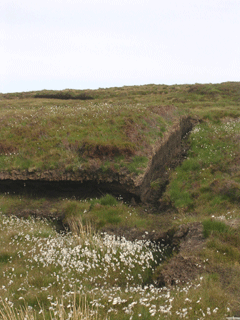
Peat banks mark the landscape on the island. (Photo: Tom Allan)
MACINTOSH: You have them standing in such a way that, well hopefully that they get the best of the wind and the sun. If you do it in that sort of shape, the wind goes through the tunnel thing there, and the sun dries on there.
[SOUND OF MACINTOSH PATTING THE PEAT]
MACINTOSH: That's them drying, and basically that's them waiting to just dry, bagged and home.
[SOUND OF BAGGING AND TRACTOR]
ALLAN: He also impresses upon me how important it is to look after the land – to replace the living layer of grass where the peat has been removed, and to cut the banks at an angle, so that they don't cave in. If you get it right, the turf is good as new in a couple of years, and the remaining peat is protected from the elements.
As we bag the dry peats, and wait for Ian's tractor, we spot another tractor on the horizon loading its own crop. It's the first time that he's seen anyone working this part of the moor in years.
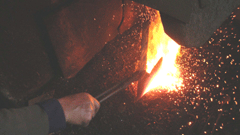
The heat of the forge. (Photo: Tom Allan)
MACINTOSH: At one time when I was youngster, every household used to do it because it was the only fuel that was available to people. Very often in a croft house you would have maybe a stove in the kitchen, which was used for cooking and heating the place, and was fueled purely by peat.
ALLAN: But Ian reckons that in recent years as few as a hundred people were still cutting, on an island of nearly nineteen thousand – the tradition was dying out.
MACINTOSH: Over the years of course, with oil becoming available and everyone getting central heating, almost everybody stopped doing peat, except for perhaps a few enthusiasts. But there could be a resurgence -- and when you think of it, a bit of exercise, fresh air...and you've got something to show at the end of it. If you go out jogging you don't come back with a bag of fuel on you're back! [LAUGHING]
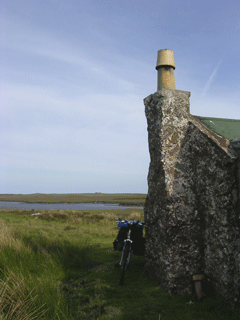
The Isle of Lewis. (Photo: Tom Allan)
[SOUND OF WASHING BOOTS AND STREAM]
ALLAN: I catch Joan and Bernard Chisholm washing their rubber boots in a stream after a few hours peat cutting. They tell me that they're cutting more this year to help pay the bills.
JEAN CHISOLM: Oh yes, this year, definitely. The peat doesn't cost us anything, plus we'll get our heating, our cooking, and our hot water. So you're getting all these three things and it didn't cost you anything, really, to get it.
BERNARD CHISOLM: A lot of people are coming out purely because of the price, and because it's available, and it costs nothing but your labor. And it's still available to all the wildlife that uses it, it's still available to the people, and it still looks good.
[SOUND OF CYCLING, GEARS CHANGING, HEAVY BREATHING]
ALLAN: I'm cycling away from Stornoway now, over the moor. Everywhere you look, you can see signs of the peat cuttings...a lot of the cuttings appear to be abandoned, unused, but there's also a fair few with the piles of peat waiting and ready to be collected…. But if I stop here …
[SOUND OF BRAKES]
ALLAN: … and look, and look to my left, you can kind of see the future of energy on this island as well, because in the distance, on the coast, I can see the island’s first three wind turbines.
[SOUND OF GENTLE WIND FADES INTO THE ROAR OF WIND TURBINES]
ALLAN: The conditions that make the island perfect for peat, also make it perfect for wind power – the strong winds that roar in from the Atlantic could generate enough electricity for more than half a million homes on the British mainland. That potential looked set to become a reality, when, four years ago, plans for the world's largest wind-farm were put forward by Lewis Wind Power, a consortium of British Energy and Amec.
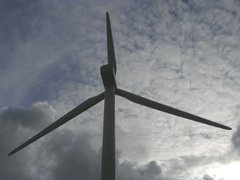
One of the new wind turbines on the Isle of Lewis. (Photo: Tom Allan)
ANGUS CAMPBELL: As far back as the year 2000 we recognized the huge potential for wind power and other renewable energies in the Western Isles. In fact. we saw it as the one economic driver that would change the economy of the Western Isles.
ALLAN: Angus Campbell of the Western Isles Council is a strong advocate of wind power, for the jobs and investment it would bring to the fragile economy of the island.
ANGUS CAMPBELL: At the moment we're looking at anything up to a gigawatt of onshore wind, something like a seventh of Scotland's whole energy needs. I'm not a technical man, but it's certainly an awful lot of energy. To put it in perspective, we only, on this island, use about 20 megawatts ourselves.
ALLAN: The project would have seen 181 turbines, each 460 feet high, spring up on the island, connected back to the mainland by a giant underwater cable – a renewable energy pipeline. It would have created around six hundred jobs, and pumped millions of dollars into the island’s economy.
But in May, the plans were rejected by the Scottish Government. The Lewis Peatlands are protected for their rare birdlife, such as the dunline, golden plover, greenshank and golden eagle. For Angus Campbell, that's putting birds before people.
ANGUS CAMPBELL: Well, it's been a huge blow to us in terms of the number of jobs we hoped to create and the number of people we thought it would support living here. If a species appears on the Barvas moors, you suddenly get a huge amount of protection. But there is very little protection for the local inhabitants that are living here and looking for work. People just don't seem to have come into this argument.
ALLAN: How did the islanders really feel about the development? A poll in 2005 showed opinion running two to one against the proposal; letters ran even more heavily against, more than 100 to one. The strongest objections came from those who feared it would end their way of life.
[SOUND OF WIND]
CATRIONA CAMPBELL: My name’s Catriona Campbell, Catriona Winehisaq in Gaelic, I’m from the village of Braga on the Ilse of Lewis.
ALLAN: Catriona Campbell tells me her Gaelic name because she wants people to understand that she's a native of the island, not some newcomer with a bee in her bonnet. Standing on the edge of her village, she points to where the wind farm would have stood.
CATRIONA CAMPBELL: Our peats are about three quarters of an hour that way, three quarters of an hour walk that is. And that's where they were proposing to put the turbines, right on top of our village peat banks. This is one of the largest pieces of intact blanket bog in Europe. My own wee daughter was out there paddling in a peat pool, a pool of damp peat, and she asked me, "I wonder if my granny did this?", and I said to her, "I know you're granny did that when she was a small child, and her granny before her. And I thought, but your grandchildren won't if this wind farm goes ahead, because it'll be concrete.
ALLAN: Catriona Campbell formed Moorland without Turbines, and they soon learnt that there were scientific, as well as personal reasons, to oppose the wind farm.
LINDSAY: Peatlands contain something like three to three-and-a-half times the amount of carbon as is stored in the tropical rainforests.
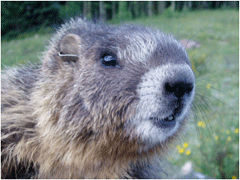
(Photo: Dr. Daniel T. Blumstein, UCLA)
ALLAN: Richard Lindsay is head of the Environmental Research Group at the University of East London. For twenty years he worked for the Government Wildlife Service as its peatlands specialist. He fears that in our rush to build wind farms in Europe's windiest places, we may end up releasing nearly as much carbon dioxide as conventional coal or gas power stations; because when you dig up or drain peatland, you begin to release the vast quantities of carbon stored in it.
LINDSAY: It's the roads that are the major issue with the wind farms. They cut across the peatland, they break up the flow of water – that is the major impact of wind farms on peat.
ALLAN: The Lewis project alone would have needed a hundred miles of access roads, and disturbed some 50 million cubic yards of peat -- making the small amounts that the islanders cut and burn seem pretty insignificant.
LINDSAY: If, in thirty years’ time, we look back and we say, “well, they did produce a lot more carbon than we expected,” then there's been this huge amount of industrial development, there's been this huge amount of landscape disruption, for very little gain.
ALLAN: Lewis Wind Power estimated that it would only take four and a half months for the working wind farm to “pay back” the carbon it released from the peat, by reducing the need for dirtier power. And a recent report commissioned by the Scottish Government suggests that wind farms built on peatland can repay all their carbon costs – including construction, installation, decommissioning and disruption of peatland – in just three years. But both estimates depend on the peat being successfully restored, and Lindsay says that that isn't so simple.
LINDSAY: Peat developed in a very very particular way, it develops very slowly over thousands of years. When developers say, "oh, we can just restore peat, we can bulldoze the peat back into the old quarries and drain lines, and so on, and then we'll just cover it over with bog vegetation, and that’s it, solved” -- there is no way that moving the peat around in that way is going to recreate the very special structure of peat. When you've damaged it you can't restore the structure.
ALLAN: Richard Lindsay says people can see and identify with rain forests and trees, and understand their importance. But they see peatland as empty space, with no practical purpose.
LINDSAY: In prehistoric times it was obviously regarded as a very sacred, special place. Really very expensive items, bronze statues, were placed as votive offerings into the bog. We've utterly lost that. Now Western cultures really have a total blind spot when it comes to peatlands, because they're seen as economically worthless.
ALLAN: But on Lewis, where life and tradition are still linked to the land, people understand how important and delicate the peatlands are. Again, Catriona Campbell:
CATRIONA CAMPBELL: For thousands of years it's been used by the people who live here – you know, we're the indigenous people. We have a very long association with our peat banks. We go back year after year to the same place. We just felt that it was an insult to us to come in and expect to take them away from us without even asking our permission.
[SOUNDS OF WALKING AWAY]
ALLAN: And perhaps the sight of those freshly cut peat banks, the sound of Tarasgeirs being forged, and the tales of paddling about in pools of damp peat, can help remind us that there is something important underneath the turf after all.
For Living On Earth, I'm Tom Allan.
Living on Earth wants to hear from you!
Living on Earth
62 Calef Highway, Suite 212
Lee, NH 03861
Telephone: 617-287-4121
E-mail: comments@loe.org
Newsletter [Click here]
Donate to Living on Earth!
Living on Earth is an independent media program and relies entirely on contributions from listeners and institutions supporting public service. Please donate now to preserve an independent environmental voice.
NewsletterLiving on Earth offers a weekly delivery of the show's rundown to your mailbox. Sign up for our newsletter today!
 Sailors For The Sea: Be the change you want to sea.
Sailors For The Sea: Be the change you want to sea.
 The Grantham Foundation for the Protection of the Environment: Committed to protecting and improving the health of the global environment.
The Grantham Foundation for the Protection of the Environment: Committed to protecting and improving the health of the global environment.
 Contribute to Living on Earth and receive, as our gift to you, an archival print of one of Mark Seth Lender's extraordinary wildlife photographs. Follow the link to see Mark's current collection of photographs.
Contribute to Living on Earth and receive, as our gift to you, an archival print of one of Mark Seth Lender's extraordinary wildlife photographs. Follow the link to see Mark's current collection of photographs.
 Buy a signed copy of Mark Seth Lender's book Smeagull the Seagull & support Living on Earth
Buy a signed copy of Mark Seth Lender's book Smeagull the Seagull & support Living on Earth

